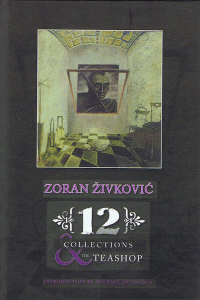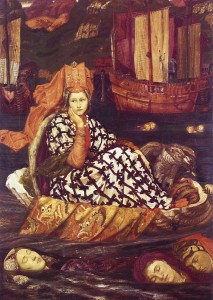 Zoran Zivkovic was another new author to me, and I’m happy to have discovered him. His Twelve Collections and The Teashop, translated from the original Serbian by Alice Copple-Tosic (PS Publishing, 2007; all quotations are taken from this text), not only made for enjoyable reading but also suggested to me a different way in which short stories might interconnect and also stand alone at the same time. I have worked on a story cycle that follows a family through several generations, but my stories were not able to stand on their own (and, to be honest, the interconnection strained itself a bit).
Zoran Zivkovic was another new author to me, and I’m happy to have discovered him. His Twelve Collections and The Teashop, translated from the original Serbian by Alice Copple-Tosic (PS Publishing, 2007; all quotations are taken from this text), not only made for enjoyable reading but also suggested to me a different way in which short stories might interconnect and also stand alone at the same time. I have worked on a story cycle that follows a family through several generations, but my stories were not able to stand on their own (and, to be honest, the interconnection strained itself a bit).
Twelve Collections and The Teashop is divided into two sections, as the title suggests. The first section is a unified selection of twelve short stories, each of which is about collections of different kinds. Each story is also complete in itself—no knowledge of the other eleven stories is required in order to understand and enjoy any individual story, no characters appear in any story other than their own. Warning: Spoilers to follow.
Zivkovic interconnects these stories in a number of ways. To begin, the plots are similar—no good end comes to any of the protagonists—and alternate between stories focused on either a collector himself (these stories are told in third person) or someone approached by a collector (stories told in first person). (All the protagonists, it’s worth noting, are male and are generally isolated.) In “Days,” the protagonist tries a special cake, called “stuffed monkey,” in exchange for “Days from the past of whoever orders it” (5), which the chef collects. Another character is approached by a collector seeking his autograph, only to discover that all the autographs in the collection are from “People who died when something fell on them” (22) and that he will die in forty-five seconds. In “Stories,” a man discovers his computer wants to collect his last story, the one he’s just finished writing (the computer warns him he will die if he writes another, and when the man tries, he has a heart attack).
Each of the third person narratives begins with similar sentences: the second story: “Mr. Prohaska collected his fingernail clippings” (11), starting at the age of eight; the fourth story: “Mr. Palivec collected photographs of himself” (25); the sixth story: “Mr. Plushal collected words” (41); the eighth story: “Mr. Pospihal collected newspaper clippings” (53); and the tenth story: “Mr. Pavek collected emails” (65). The collector-protagonists all have surnames beginning with the letter “P.” Continuing with “P” as an indicator of interconnectedness, the color purple appears in each story, sometimes casually—in “Stories,” the computer screen goes purple; in “Deaths,” a hospital patient is visited by a man “wearing a long purple coat” (60); Mr. Pospihal keeps each of his clippings in “a transparent purple folder” (56)—sometimes more expansively, as in “Days,” which opens thus: “When I entered the pastry shop, a purple wave swept over me” (3). Thematically, each story deals with memory of some kind, and purple therefore seems a natural color choice (purple seems to be associated frequently with Mnemosyne, the Greek Titan of memory).
The last story of Twelve Collections is titled “Collections” and begins, “Mr. Pokorni collected collections” (77). We find out that the collections Mr. Pokorni has collected and stored in his house are the collections from the previous stories. No attempt is made to explain why or how Mr. Pokorni came to possess these collections (or how Mr. Pospihal’s newspaper clippings collection, which he carefully cut up and threw out at the end of his story, can appear whole and complete in Mr. Pokorni’s home). At the end of the story, having brought in one more collection but realized he had no room, Mr. Pokorni destroys all of the collections. Our sly narrator—who earlier in the story alludes to his “privileged position as omniscient storyteller” (78)—offers no explanation for why Mr. Pokorni trashes his collection:
…one might pause to wonder why Mr. Pokorni had acted this way. This question, unfortunately, must remain unanswered. Even your omniscient storyteller is not powerful enough to peer into the head of this rich collector. Perhaps this is for the best. What would be the point in finding out why he destroyed the collections? It certainly would not bring them back. (81-82)
I love the playfulness of the narrator here: he’s “omniscient” but “not powerful enough to peer into” Mr. Pokorni’s head. The explanation would not bring back the collections, so what’s the point of understanding why? I suppose as a reader my response might have been frustration, but in the majority of the eleven previous stories no attempt is made to explain why someone begins his collection, so our narrator’s refusal to explain why Mr. Pokorni ends his seems in keeping with the rest of the stories and perhaps even offers an underlying criticism of the act of collecting itself (certainly most of these characters aren’t made happy by their collections).
Even though I enjoyed the first half of Zivkovic’s book immensely, I think my favorite story is the last one, “The Teashop” (at twenty-two pages, I’m not sure it’s long enough to be counted even as a novelette). The first of the two central things I enjoyed most about this story is the writing: Zivkovic includes a startling amount of specific detail that never feels overwhelming, as in this passage from early in the story:
Miss Greta opened a large umbrella with alternating triangles in two shades of brown that matched her coat, shoes and handbag. She waited for two cars to pass so they wouldn’t spray her and then headed across the square with swift little steps. Even though she chose carefully where to step, it was inevitable that she got splashed. When she reached the arched roof covering the entrance to the teashop, she turned around and shook out her umbrella, returning a flurry of drops to the rain. (86)
The descriptions of action are precise, particular, and yet evoke so artfully the character of Miss Greta—everything about her is precise and particular. Sometimes evocative character description doesn’t come from details but from style.
The second thing I enjoyed most was the conceit, which is to say the structure of the story itself. Forgive the straight-on summary, but I feel it will add to the understanding of the conceit: Miss Greta comes to a teashop while waiting for a train (she has left her suitcase with the luggage window); in the teashop are six people: the waiter, the cashier, an old man, a young couple, and another woman. Zivkovic reveals to us that Miss Greta is a woman not given to adventure, but she decides to indulge herself with an unknown, exotic tea: “She chose the last [tea] on the menu—tea made of stories. This was partially influenced by the brief recommendation next to it: ‘You need this’” (88). After Miss Greta takes her first sip of tea, the waiter tells her a story about an executioner who decides to leave the family profession and falls in love with a nurse. There is a fire and he is presumed dead. Miss Greta loves the story, as it has all the elements she loves. She takes another sip, and the cashier comes over and tells her a story about what the nurse does next (ultimately she joins the circus, where she begins working as an assistant to a brother and sister illusionist team; but one night disappears the nurse/assistant disappears during the middle of the act as she’s supposed to but she doesn’t reappear. Miss Greta loves this story even more. Another sip of tea, and the young couple come over and in tandem tell what happens next to the brother (told by the man) and the sister (told by the woman). (It’s at this point in the story that I realize how the story’s going to end, but I still can’t wait to get there.) The male illusionist ends up in prison, and the female illusionist becomes involved with an archaeological dig. The last sip, and the old man and the other woman come over to tell the tales of an old man the male illusionist meets in prison and the archaeologist’s wife. Eventually, in these last tales, the old prisoner and the archaeologist’s wife end up on a train, where there is also a man who turns out to be the executioner from the first story. The former executioner gets off the train and walks past Miss Greta, who is looking for the luggage window. The story ends and Miss Greta realizes, of course, that each person in the teashop had told her their story, and the readers see how interconnected those stories were: in the end Miss Greta—who, we’re told earlier, leads a rather lackluster life—becomes part of their stories, part of their adventure. She tears up her baggage claim check to “resounding applause” (107) from the others in the teashop; she has decided to become part of their collective story in more ways than one.
The interconnectedness of stories Zivkovic makes explicit in the twelfth story of the first half of the book, “Collections,” is echoed in the end of “The Teashop,” and what I admired is that even though I figured out what he was doing by the third story in the teashop, that knowledge of the “twist” ending did not deter me in the slightest from enjoying the story. Sometimes, in my own writing, I don’t try hard enough to make my sometimes tricky conceits more obvious to the audience (and I don’t know why I can’t make myself be less subtle), but Zivkovic has certainly given me something to mull over in terms of accepting that it’s all right if the reader figures out the ending earlier if the trip there is well done.





